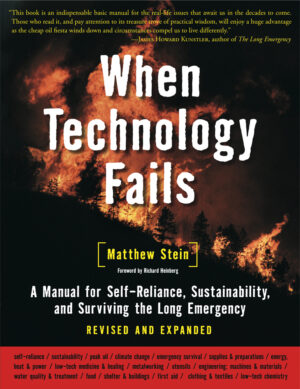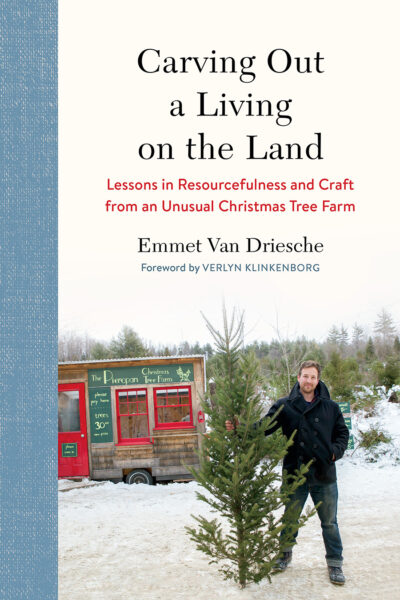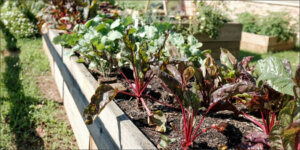Make Your Own Shoes: When Technology Fails
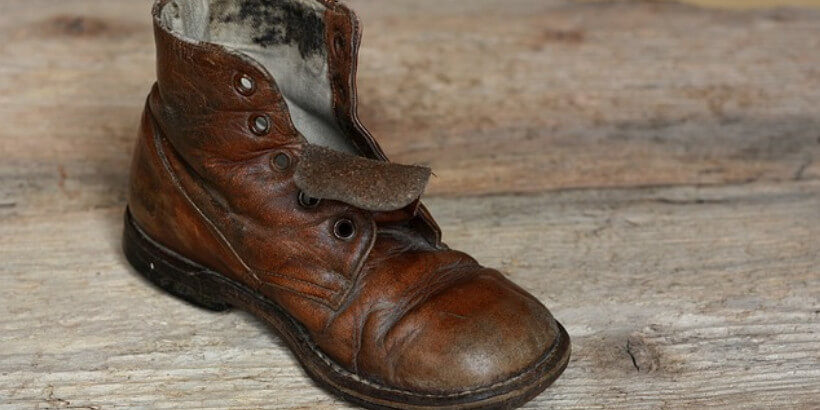
Matthew Stein’s book, When Technology Fails: A Manual for Self-Reliance, Sustainability, and Surviving the Long Emergency, offers this quick guide to making your own shoes. The book is packed with useful tips for saving money, living a sustainable lifestyle, and surviving in a savage, Road Warrior-like dystopia.
We hope that will never happen, but if it does, at least your toes will be stylin’ and safe.
The following article was adapted for the web from When Technology Fails: A Manual for Self-Reliance, Sustainability, and Surviving the Long Emergency.
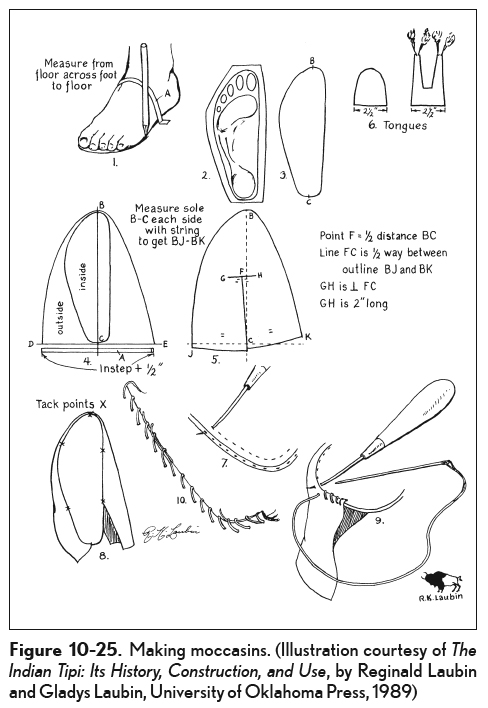 In pioneering days, a good-fitting pair of shoes was a truly valuable possession. Often, when shoemakers passed through a village, they would make several pairs of shoes for each person who could afford them, as it might be years before they had the opportunity to purchase another pair of good-fitting shoes. Making your own traditional boots is not easy, but sandals and moccasins are easy and rewarding leathercraft projects for the beginner.
In pioneering days, a good-fitting pair of shoes was a truly valuable possession. Often, when shoemakers passed through a village, they would make several pairs of shoes for each person who could afford them, as it might be years before they had the opportunity to purchase another pair of good-fitting shoes. Making your own traditional boots is not easy, but sandals and moccasins are easy and rewarding leathercraft projects for the beginner.
Soles can be attached with stitching, primitive hide glues, more modern glues such as Barge Cement, or nailed in place (cobbling). McNett Corporation makes an excellent urethane shoe-repair cement, called Freesole, which can be used to repair holes in shoes and worn soles or glue new soles in place. Freesole is available through backcountry suppliers and shoe-repair shops. It is reportedly much stronger than Barge Cement and withstands much higher temperatures, but I have not tried it yet for gluing soles in place. See Chapter 14 for instructions on how to make your own glues.
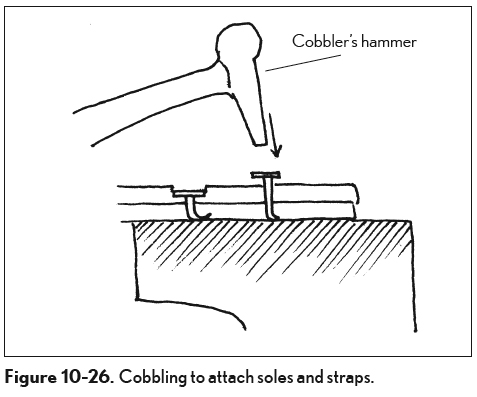 Sinews, heavy waxed nylon thread, or multistrand wire are all good, strong materials for stitching together footwear. If you scavenge wire for thread, make sure that the strands are fine or else constant flexing will cause the metal to fatigue and the wire to break. Shoe soles and straps can be nailed together by a process called “cobbling.” Shoe soles that were attached by simply nailing short nails through the soles into the midsole would soon work loose and fall off. Traditional cobblers use nails with slender, tapering tips that are nailed through the straps and soles against a metal anvil, bending the nail tips backward so that they form a hook shape. By bending the nail tips, the sole or strap is captured in such a way that the nails can’t easily work their way back out.
Sinews, heavy waxed nylon thread, or multistrand wire are all good, strong materials for stitching together footwear. If you scavenge wire for thread, make sure that the strands are fine or else constant flexing will cause the metal to fatigue and the wire to break. Shoe soles and straps can be nailed together by a process called “cobbling.” Shoe soles that were attached by simply nailing short nails through the soles into the midsole would soon work loose and fall off. Traditional cobblers use nails with slender, tapering tips that are nailed through the straps and soles against a metal anvil, bending the nail tips backward so that they form a hook shape. By bending the nail tips, the sole or strap is captured in such a way that the nails can’t easily work their way back out.
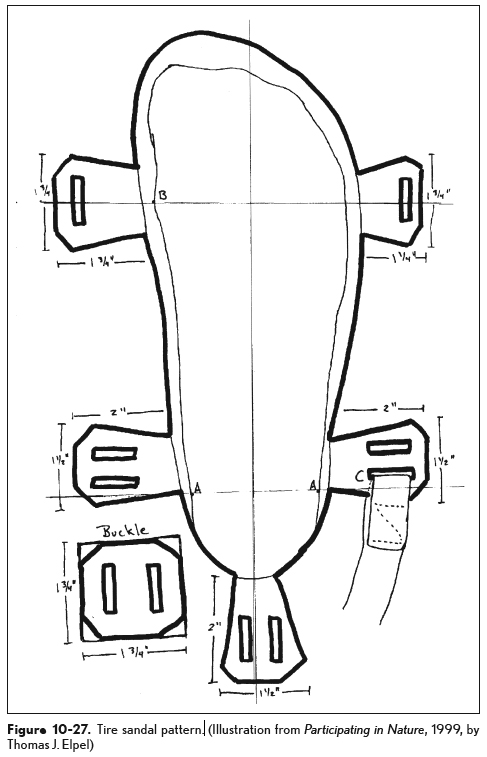 Cast-off rubber tires make great sandals and soles. Thomas J. Elpel, author of Participating in Nature1, believes that the best all-around homemade footgear is a tire sandal worn over a moccasin. You can wear holes in a pair of moccasins in less than a day of rough travel, and tire sandals can wear a hole in your feet (blisters) in a few hours. When you wear the two together, you get the comfort of moccasins combined with the durability of tire sandals. Around camp you can wear just the moccasins. When fording rivers, wear just the sandals. Using a band saw, sharp knife, chisel, hacksaw, or coping saw, cut tire sandals and buckles from older-style tires that don’t have steel belts.
Cast-off rubber tires make great sandals and soles. Thomas J. Elpel, author of Participating in Nature1, believes that the best all-around homemade footgear is a tire sandal worn over a moccasin. You can wear holes in a pair of moccasins in less than a day of rough travel, and tire sandals can wear a hole in your feet (blisters) in a few hours. When you wear the two together, you get the comfort of moccasins combined with the durability of tire sandals. Around camp you can wear just the moccasins. When fording rivers, wear just the sandals. Using a band saw, sharp knife, chisel, hacksaw, or coping saw, cut tire sandals and buckles from older-style tires that don’t have steel belts.
Use the pattern shown in Figure 10-27 as a rough guide. Start by tracing the outline of your foot on a piece of paper. Add about 3/8 inch to the front and sides, but not the heel area. Make two marks at the centers of your anklebones (A) and a mark at the side of the ball of your foot, directly behind your big toe (B). Draw lines through these points, as shown in the pattern, to help you locate the strap loops. The strap loops are designed for 3/4-inch-wide webbing. If you use a different size of strap material, adjust and customize your pattern as necessary to fit your foot. Cut out your pattern as you would a paper doll, and lay it on the tire to mark the outline for cutting the rubber (Elpel 1999, 134).
Click here to listen to the story of the shoe cobbler on NPR.
Notes
1. Elpel, Thomas J. Participating in Nature: Thomas J. Elpel’s Guide to
Primitive Living Skills. Pony, MT: HOPS Press, 1999.
Recommended Reads
Recent Articles
Many know the effects of catnip on our feline friends, but few realize that catnip has medicinal effects for humans. From stomach aches to reducing fevers, catnip is a versatile herb with many benefits. The next time you grow this plant for your cat you may end up taking a few cuttings for yourself! The…
Read MoreWhether you’re looking to replace your end-of-the-day cocktail, relax before bed, or want something new to add to your tea, this non-alcoholic mocktail syrup base will do the trick. Delicious and all-natural, take a sip of this nightcap mocktail and feel your troubles melt away. The following is an excerpt from Herbal Formularies for Health…
Read MoreSurprisingly, medicine can actually be delicious. This anti-inflammatory smoothie uses natural (and tasty!) ingredients to help reduce inflammation caused by any number of circumstances. The following is an excerpt from Herbal Formularies for Health Professionals, Volume 4 by Jill Stansbury. It has been adapted for the web. RECIPE: Ginger and Pineapple Anti-Inflammatory Smoothie This is an all-purpose…
Read MoreWant to witness the magic of the mini-forest? When you practice The Miyawaki Method, a unique approach to reforestation, you’ll see an empty lot or backyard transform into a biodiverse forest before your very eyes. The following is an excerpt from Mini-Forest Revolution by Hannah Lewis. It has been adapted for the web. Photo Credit:…
Read MoreWhen you plan out how you want your garden to look and operate, you’re setting yourself up for long-term success. Here are some helpful tips on how to plan the best garden this upcoming growing season! The following excerpt is from The Resilient Gardener: Food Production and Self-Reliance in Uncertain Times by Carol Deppe. It has been…
Read More

